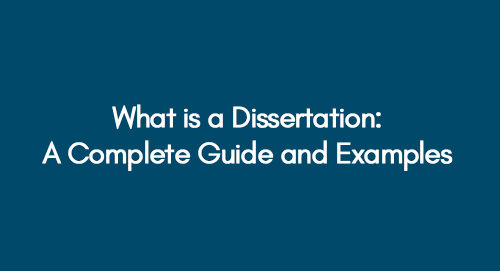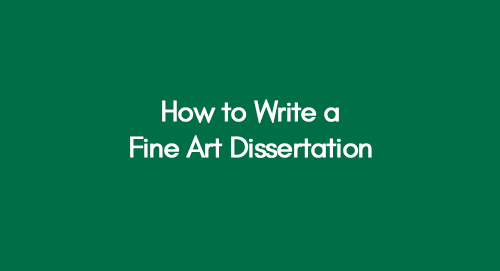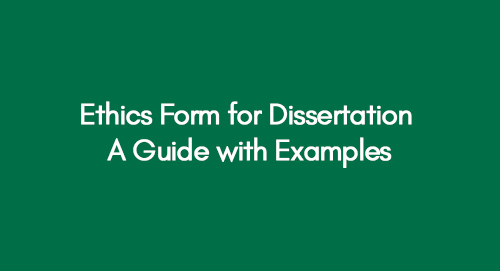
Top Business Dissertation Examples | Review and Download
November 25, 2022
Top MA Dissertation Examples For Student Guidance
November 28, 2022A dissertation is a research paper typically required for students pursuing a doctorate in fine arts. This paper will showcase the student's original research and findings in the field of study. Because this type of paper holds great weight in the student's overall grade, it is important to take the necessary steps to compose a well-written, unique dissertation.
In this guide, we will offer some tips with fine arts dissertation examples on making the process a little easier.
Example: 1 Comparison Between Gendered Role of Women in Christianity and Islam
What is Fine Art?
A lot of people might not understand why fine arts are important. They don't consider it a true type of education; rather, they perceive it as a hobby. However, the reality is that learning fine art is among the most crucial things a person can do. It helps to promote creativity, critical thinking, and problem-solving skills.
Fine arts are defined as any creative skill used to express the artist's ideas, emotions, or thoughts. It could be through music, dance, painting, sculpting, drama, or writing. Anything that someone uses to express themselves can be considered a form of fine art.
The Importance of Fine Arts in Education
Most people might not see the importance of learning these things. They seem like hobbies rather than anything that could teach you something important. But the truth is, fine arts are some of the most important things you can learn.
Here are three reasons why fine arts are important:
- Fine arts help to promote creativity
- Fine arts help to teach critical thinking and problem-solving skills
- Fine arts help to foster an appreciation for beauty and aesthetics
A. Promoting Creativity
One of the most important aspects of fine arts is that it helps to promote creativity. Being able to think outside the box and generate fresh ideas is crucial in a world that is continuously changing and developing. Fine arts help to encourage this by teaching people how to think creatively and see the world in new ways.
B. Teaching Critical Thinking and Problem-Solving Skills
Another benefit of fine arts education is that it teaches critical thinking and problem-solving skills. These are skills that are essential in all aspects of life. By learning to think critically and solve problems, students will be better equipped to handle whatever challenges they face.
C. Fostering an Appreciation for Beauty and Aesthetics
Finally, fine arts help to foster an appreciation for beauty and aesthetics. In a world that is often harsh and ugly, it's important to be able to appreciate beauty when we see it. By exposure to different art forms, students can learn to appreciate the beauty in all kinds of different things.
Important Things to Comprehend While Writing a Fine Arts Dissertation
1) Select a Topic that You are Passionate About
You will be spending a lot of time on this paper, so selecting a topic you are interested in and having some background knowledge is important. It will make the writing process much more enjoyable and less daunting.
2) Choose an Original Angle
Since you are expected to contribute new knowledge to your field with your dissertation, choosing an original angle or perspective from which to approach your topic is important. Do some research on what has been done previously in your field to get some ideas of what area you would like to focus on.
3) Do Thorough Research
A dissertation is meant to be an educated, well-researched opinion on your chosen topic. It is important to consult experts in the field as well as academic journals to gain different perspectives and deepen your understanding of the subject matter. That will also help you make your argument because you will be able to anticipate counterarguments and address them accordingly.
4) Write Clearly and Concisely
This type of paper requires formal language and a clear structure to convey complex ideas effectively. Be sure to proofread your work for errors before submitting it so that your argument comes across as strong and credible.
5) Cite Your Sources Appropriately
Because dissertations are heavily based on outside research, it is crucial that you give credit to the authors whose work you are using. Not only is this good academic practice, but it will also prevent you from being accused of plagiarism. Be sure to use proper citation format for both in-text citations and bibliographies.
Fine Art Dissertation Examples
Dissertations in the field of fine arts allow students to explore their creativity and apply it to real-world scenarios. The best dissertations are those which are able to capture the attention of the reader and communicate the message of the author engagingly. In this article, we will provide some fine arts dissertation examples for your reference.
- Example 1:
"A Comparative Study of Chinese and Western Art" by Anna Zhao
This dissertation compares and contrasts the differences between Chinese and Western art. It discusses the history, theory, and philosophy behind both traditions and argues that there is much to learn from a comparative study of both.
- Example 2:
"The Impact of Technology on Contemporary Art Practice" by Sarah Wilson
This dissertation looks at how technology has changed the ways in which artists work. It discusses how technological advances have made it possible for artists to create works that would not have been possible before and how this has changed the nature of art itself.
- Example 3:
"Body as Canvas: A Study of Tattoo Art" by James Smith
This dissertation looks at how tattoo art has evolved over time, from its early beginnings as a form of tribal body markings to its current status as a highly respected form of self-expression. It discusses the different techniques used in tattooing and the cultural significance of tattoos in different societies.
- Example 4:
"The Role of Music in Visual Art" by Rebecca Jones
This dissertation looks at how music can be used as a means of expression in visual art. It discusses how music can be used to convey mood, emotion, and atmosphere in a painting or sculpture and how it can add another layer of meaning to an artwork.
Fine Arts Topics for Your Dissertation
- The Impact of Social Media on the Fine Arts
- The Relationship Between Art and Politics
- The Role of Art in Society
- The Function of Art in Religion
- Aesthetics and the Philosophy of Art
- The History of Art in the 20th Century
- The Development of Modern Art
- Contemporary Art Movements
- Street Art and Graffiti
- Public Art Installations
- Fine Arts and Technology
- The Business of Fine Arts
- Fine Arts Education
- Preserving Fine Arts and Historic Buildings
- Promoting the Fine Arts
Conclusion
Writing a fine arts dissertation can be difficult. Thorough research is key to ensuring that your argument is well-rounded and supported. And finally, remember to write clearly and concisely while citing your sources appropriately throughout the paper. If you follow these simple tips, you should end up with a unique and successful dissertation!





















